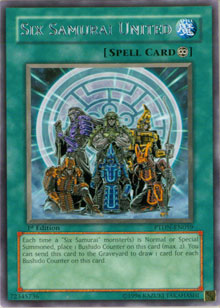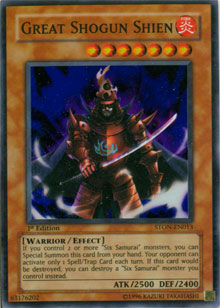These days, there’s one deck to beat. Dark Armed Dragon Return is on top, and players who can afford the cards know that being able to OTK the opponent consistently on the second turn is worth trying. The strength, power, and speed of this Return from the Different Dimension variant is unmatched by any Return strategy before it. Faster than Zombies and more consistent than Perfect Circle, Dark Armed is all the rage.
Players not caught up in the whirlwind of making the perfect Dark Armed Dragon build are looking for ways to take it out. Anti-metagame strategies are quite successful during times like these, where one archetype is commanding play from well over half the competitive Shonen Jump Championship duelists. Dark Armed commands that respect, and as such, finding a good way to beat it is a solid strategy for preparing for the next Shonen Jump. Many players have turned to recently improved Cosmos and Diamond Dude Turbo builds, but DDT is inconsistent and Cosmos only fuels the Return fire faster.
With all the hype around the Dragon moving into Shonen Jump Championship Houston, very few players saw Jonathan Moore and his band of Six Samurai as much of a threat. Still tagged as an old, inconsistent, and overly aggressive archetype, Six Samurai wasn’t really looked at as a potential anti-metagame deck. Yet through true devotion, lots of playtesting, or pure luck, Jonathon Moore knew that Samurai could beat Return, and with that confidence took this Samurai build to victory in Houston:
 Monsters: 20
Monsters: 20
1 Enishi, Shien’s Chancellor
1 The Six Samurai - Kamon
2 Spirit of the Six Samurai
2 Cyber Dragon
2 The Six Samurai - Zanji
3 The Six Samurai - Yaichi
3 The Six Samurai - Irou
3 Great Shogun Shien
3 Grandmaster of the Six Samurai
What’s so bizarre about Moore’s deck is that it differs little from the standard Samurai build. There are some new cards thanks to a few new options from
Phantom Darkness, but the idea remains the same: apply an intense amount of pressure with your Samurai monsters. Moore can play a fast game where he simply tries to swarm his opponent by dropping as many monsters as possible. A strategy like this works when backed up with
Solemn Judgment and
Great Shogun Shien reducing the number of spell or trap effects your opponent can use and negating his or her most important counter. The other method is to play a control style, chipping away at the opponent until he or she is forced to commit cards to destroying your Grandmasters (which achieves nothing in terms of your total card presence), eventually running out of options.
 Phantom Darkness
Phantom Darkness added
Six Samurai United, a powerful draw spell reserved only for Samurai players. For a deck that depends on drawing key cards as much as Samurai does, this is some much-needed support. Moore can hit the cards that beat specific matchups much faster and more often, and that’s the type of consistency necessary to win a Shonen Jump Championship.
However one spell card can’t take a struggling archetype and turn it into the best. The reason Samurai gained so much strength was the way the metagame changed while they did not. Since Samurai are not considered to be much of a threat, players don’t take into account the great matchup it has with the Return deck. It just so happens that Dark Armed and Magical Explosion both get creamed by Moore’s Samurai cards.
Great Shogun Shien is the first power card at Moore’s disposal. Boasting impressive stats and an ability that can special summon him for free, the Shogun is a damaging force just to have on the field. Now factor in his effect, which limits the opponent to one spell or trap card per turn. Obviously you can see how this is a big problem for Magical Explosion, which needs to use many spell cards in a single turn to cycle through the deck and fuel the graveyard.
Dark Armed Dragon suffers at the hands of the Shogun as well. The deck is designed to be very fast, suddenly pumping monsters out of play and back again with Allure of Darkness and Escape from the Dark Dimension. Preventing the Dark Armed player from using both cards in one turn takes away all the speed and surprise that leads to damaging the opponent’s life points or card counts.
Solemn Judgment and Phoenix Wing Wind Blast are two of the cards designed to protect Shogun Shien and his buddies. At the same time, both can shut down a spell or trap card the  opponent plays during his or her turn, though Judgment’s negate effect means that the opponent can still play another spell or trap that turn. Judgment can outright deny the card, while Wind Blast can delay the opponent’s use of a trap by spinning it back. Blasting a Premature Burial or Escape from the Dark Dimension is just as useful too, as you prevent the opponent from developing his or her field presence.
opponent plays during his or her turn, though Judgment’s negate effect means that the opponent can still play another spell or trap that turn. Judgment can outright deny the card, while Wind Blast can delay the opponent’s use of a trap by spinning it back. Blasting a Premature Burial or Escape from the Dark Dimension is just as useful too, as you prevent the opponent from developing his or her field presence.
Reasoning is one card I really like in the Samurai deck. Most of the Samurai monsters are different levels, with four being the most prevalent. However, since most of the Samurai monsters need a second Samurai to get their effects, Moore rarely cares which one he special summons. Reinforcement of the Army can find the specifics when necessary, and slain Grandmasters can target other key Samurai monsters. Reasoning offers a quick way to tear through the deck in hopes of finding Shogun Shien or Grandmaster, while adding a lot of OTK potential as well.
Spirit of the Six Samurai is the other new card Moore used. The Union ability of the Spirit gives the deck even more draw power, turning on-field investments into fresh cards in the hand. At the same time the Spirit reinforces the monster it’s attached to with 500 ATK and DEF, as well as a one-time protection from destruction. The Spirit is also a Six Samurai monster itself, meaning that it can be turned into a monster and destroyed by a Samurai’s effect to save a better one.
Moore’s Samurai deck is built to have any and all options accessible to him when needed. The speed and raw aggression in this build allow it to take advantage of weak players, while Great Shogun Shien, Solemn Judgment, Phoenix Wing Wind Blast, and Grandmaster of the Six Samurai all weaken an opponent just from their own effects, allowing the rest of the deck to take over.
—Matt Peddle